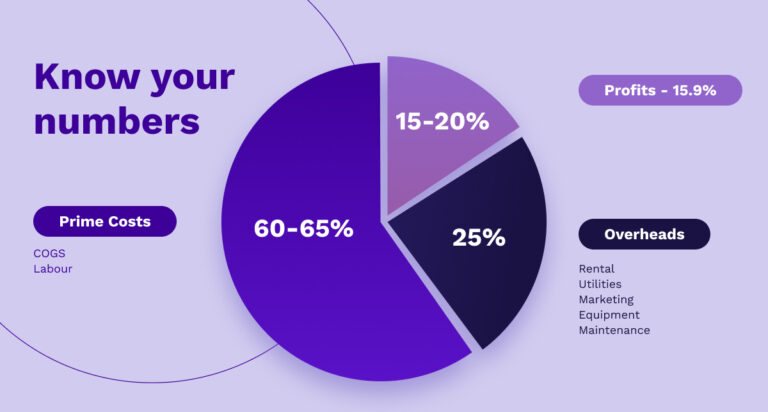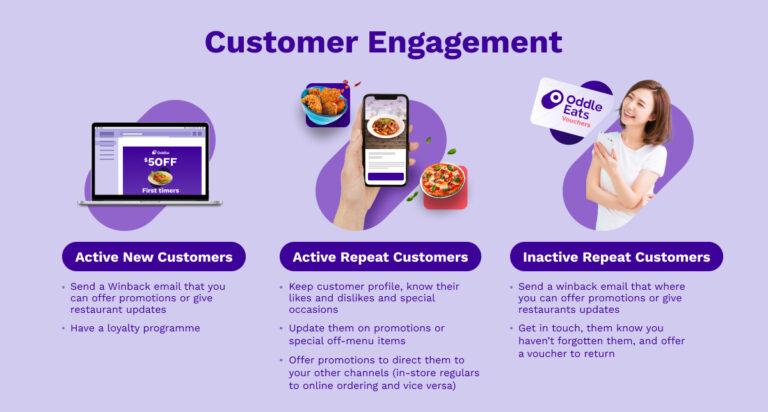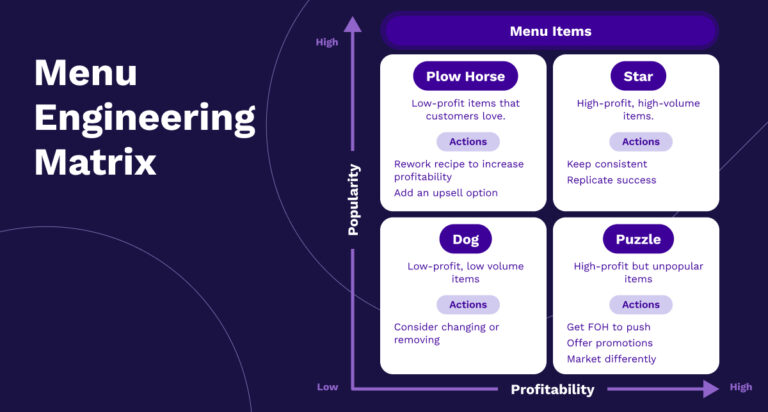Restaurant Management: A 5-Step Guide to Maximum Profitability

A restaurant might win awards, have loyal customers, and be well-critiqued. But at the end of the day, there’s only one metric that keeps it open: profitability. The best restaurants not only provide top-tier experiences, they also identify opportunities for long-term profits long before others can. In this guide, we go through what makes successful restaurants, and provide management tips for you to keep ahead of the most common issues faced in the industry.
1. Know Your Numbers
These three words apply to literally any business. Making good food is just a small (although extremely important part) of successful restaurant management. Staying on top of your budget is paramount in order to survive, scale, and prosper.
Firstly, work out your pro forma budget. This is the projected budget you would have for the coming period, which can be calendar months or four weeks, depending on your accounting practices. Ideally, this should be based on historical P&L and adjusted for future forecasts.
Some examples include:
- Leaner months, and months with higher volumes that you can respectively plan for
- Ingredient prices that change with the seasons
- Inflation
- Scheduled maintenance of equipment
In an ideal scenario, your restaurant would be making 15% to 20% in profits. As a general guide, this means allocating 60 to 65% of your budget (which comes from the previous month’s revenue) to your Prime Costs, which is the Costs of Goods Sold (COGS) + Cost of Labour. Meanwhile, the remaining 25% or so will go to your overheads.
The reality is that most restaurants average single-digit profit margins. To hit that much-sought 20%, one has to get on top of their prime costs.

Prime cost: COGS
Of all the expenses you have, COGS is perhaps the one you have the most control over through smart pricing and menu engineering (see Section 4). COGS of your food is the cost of whatever inventory you have used in that time frame.
COGS is calculated as: (Value of Inventory used + Spoilage) ÷ Total Revenue
An ideal total COGS would be around 30%, although this might vary depending on the budgeting of your business’s other costs and the kind of restaurant you are running.
Prime cost: Labour
It might sound counter-intuitive, but getting on top of your labour costs means investing in retaining manpower. Loyal, well-trained staff can do wonders for revenue and ensure smooth operations.
The National Restaurant Association in the US estimates that the average restaurant loses $150,000 yearly in staff turnover. This is because well-trained staff bring food quickly to the table, are good at upselling and pushing menu items, and make less mistakes.
If you have a system for inventory (and you should), there shouldn’t be a reason why you don’t have one for training, promoting, and rewarding staff too.
Overheads
While overheads like utilities, rental, and nonfood supplies cannot be avoided, strategic management can help you save on costs. Savings on utilities can be achieved by doing the homework on your equipment (opting for an eco-friendly dishwasher for example), while things like cleaning supplies and towels can be bought in bulk if you have the storage space.
After paying for so many tangible things – labour, goods, and space – marketing often becomes an afterthought, which is a major mistake that many restaurateurs make.
Fortunately, there are ways to make your marketing dollar generate outsized returns. Consider Oddle’s many value-added services. Oddle’s e-Shop has a lower cost compared to most marketplace platforms. It also runs a free restaurant reservation system, as Oddle believes in helping restaurants thrive by maximising their sales — and then growing with them.
This is exemplified in Oddle Tickets, a prepayment solution where restaurants are only charged a 3.4% fee when tickets are bought and used. This generates immediate cash flow as both your restaurant and Oddle are securing confirmed sales – unlike other reservation systems which only represent potential earnings. The use of tickets also minimises no-shows, which, on average, accounts for a hefty 30% loss of revenue. Prepayment has also been shown to increase spending from customers, as shown in a study done by the University of Denver’s Daniels College of Business.
Thankfully for restaurateurs, much of sales conversions now happen online-to-offline (O2O) – so there’s no need to take out costly print or television ads. With the help of a tech-driven, merchant-centric platform like Oddle, it’s easy to generate outsized returns on an overhead like marketing.
Get your guys on board
A good captain is one whose ship can run perfectly fine even if they had to take the day off. Your restaurant management team should also be running their departments by the numbers – the head chef and bar manager should be buying ingredients and planning menu items with costs and risks in mind; and the GM should be planning staff schedules with military precision.
2. The Five ‘Sauces’ of Revenue Growth
When you have optimised your costs, it’s time to look at increasing your revenue – something that can be hard to do in an industry that’s fraught with obstacles.
We work with many restaurants, and the same few problems come up time and again: rising COGS, unreasonable landlords and high rental, manpower costs and shortages.
Successful restaurants face these problems too, but they stay ahead by constantly increasing their revenue in addition to cost management.
They do this by increasing one or more of the following factors:
- Number of customers
- Frequency of purchase
- Average order value
- Restaurant occupancy
- Table turnover rate
The beauty of this guide is that all of the factors above are multiplicative. Should you grow each of these categories by just 15%, your total revenue will have more than doubled.
In Peter LeSar’s best-selling book, Restaurant Strong, he states that “stacking up large numbers of loyal customers with high lifetime values is the growth model of restaurants”. The goal is therefore to attract new customers, re-attract diminished customers, and convert both groups to loyal ones.
One only needs to look at one of the most successful restaurant groups in the world, McDonald’s. It’s a restaurant that has multi-generational loyalty, high profit margins, and a constant stream of new menu items to garner curiosity and attract new fans.
3. Make Your C.A.S.E. Capture, Aggregate, Segment, and Engage Your Customers
Now that we’ve discussed multiplying revenue, it’s time to look at how you can increase the number of your customers and retain them. According to consumer research, just “a 5% increase in customer retention can increase company revenue by 25-95%.”. By ensuring that your regular customers return, along with creating new, repeat customers, restaurateurs can improve sales predictability and consequently achieve more accurate budgeting.

Capture and Aggregate
As they say, data is king. Oddle gives you a 360-degree overview of your customer database by combining data from Oddle’s Payment Terminals, QR Ordering, and its free restaurant Reservation system. Meanwhile, its Merchant Marketing solutions give you the ability to discern actionable insights from the data you receive. This way, you get consistent customer and sales data, which makes management of your pro forma budget easier.
Segment
When all your data is in one place, you can segment them into two broad categories: active and inactive. From your active pool of customers, you can further discern your loyal customer base and your ‘growth pool’, i.e. the customers with high income potential that you want to be returning and spending more.
Engage
With your customers segmented, you can now tailor your actions to the particularities of each group. Entice new customers to return with loyalty programmes, keep returning customers coming back with new promotions, and re-engage lapsed customers with bigger vouchers.

4. The Price Is Right — Or Is It?
Getting your menu and price management right can increase your average order value, a key revenue multiplier. This can be done by providing customers with incentives to spend more.
Consider:
Add-ons that you can upsell
Providing the option to add an egg to a pasta dish, or a few grams of truffles on top of a baked potato – which your servers can actively upsell – potentially increases your average order value. By asking a simple question, “Would you like fries with that?”, McDonald’s has added millions to their revenue since they started the practice back in the 1970s.
Self-service options
Providing customers with at-the-table ordering solutions like Oddle’s QR ordering can save you manpower and enhance customer service. Plus, digital orders tend to be larger than orders made face-to-face. Oddle’s QR ordering solution, for example, has seen a broad 20% increase in average orders.
Bundling menu items
Combo meals and prix-fixe menus – especially when prepaid using a service like ‘Tickets’ (part of Oddle’s free restaurant reservation system) – can help you plan your inventory. For combo or set meals, customers also get a sense of value.
Loyalty programs
Menu engineering
Smart menu pricing can maximise your profitability. While an ideal COGS (see above section on Prime Costs) is 30%, this does not have to be flatly applied to all menu items. For example, if steak sells in large quantities at your restaurant, you can let it have a higher COGS (by virtue of pricing it lower) and keep it below the price threshold that puts people off from ordering it.

More importantly, pricing decisions should be made based on data. Look at transaction patterns and numbers – which Oddle provides across its products – to figure out which items sell well, and when.
Dollars and sense
Creating a sense of value or lower prices by using price psychology can do wonders for moving profitable items on your menu. There’s a reason why so many items are priced with a .99 or .90 value — it works. Customers might be conscious of what you’re doing when you charge $13.90 instead of $14 for a burger, but they still somehow register it as a measurably better deal.
Other times, you can offer an extremely profitable item for a steep discount or in a bundle to create perceived value. Take the McDonald’s value meal, where, for just a few dollars more, you can get a drink and side at roughly a 50% discount with your burger. However, McDonald’s still makes money off these add-ons since their profit margins on them is close to 90%.
Your revenue sources
Times have changed, and so should restaurant management. Delivery and online traffic are channels that can no longer be ignored as they are significant revenue drivers. As a guide, delivery should at least bring in 20% of your revenue, especially since it can scale beyond the number of tables and covers you have. E-store merchandise that easily fits into your kitchen SOPs – like bottling jams or sauces that you already make – can also be an additional source of revenue. These items can easily be integrated into an existing Oddle e-Shop that is used for deliveries.
5. Real Estate
Take control of your precious real estate with Oddle’s free restaurant reservation system
Physically, real estate refers to your restaurant floor space. Are your tables too far apart or too close to each other? Do you have too few tables? Are you always seating 2 pax at a 4 pax table? Managing your restaurant occupancy is a balance between maximising it, but also ensuring customers remain comfortable.
Then there’s your table turnover rate. Are you making at least 2 turns a shift? Hitting your optimum turnover rate is a game of knowing your average service cycle, minimising the time between each turn (something that can be done with the help of a digital floor plan like Oddle’s), and preventing no-shows.

Using Oddle’s free restaurant reservation system not only means you cut down on costs (since it’s free), but can also leverage on the Tickets function, where customers prepay and are more invested in showing up. With Tickets, Oddle takes a small 3.4% cut, so it’s also incentivised to help sell more.
Digital real estate
Just like how prime real estate for F&B are areas with high footfall, prime real estate online are places where your brand will get quality attention. Online-to-offline sales are a key part of any F&B business, and marketing spend is equivalent to “rental” in this online space.
Oddle’s Marketing as a Service (MaaS) solution allows you to take full advantage of the kind of conversions that being in prime digital real estate brings – think targeted EDMs that bring back existing customers, or top-of-funnel social media advertising that brings your brand tens of thousands of eyeballs.
At a time when striking the right chord with netizens can easily bring you the attention of millions, we’d say that the management of your digital real estate is even more valuable than any amount of physical footfall.
